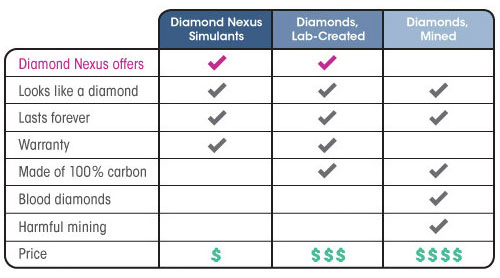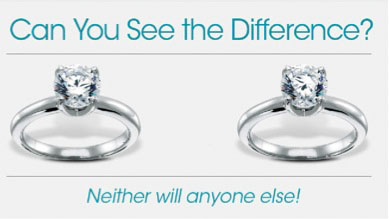Marketing Confusion —
What is this gem anyway?
 Is a stone a diamond because its weight is in carats? Is a brand trustworthy because it's famous? Can you believe everything you read on the Internet?
Is a stone a diamond because its weight is in carats? Is a brand trustworthy because it's famous? Can you believe everything you read on the Internet?
The increasing demand for lower-priced jewelry, plus the technological advances in altering and manufacturing gems and gem wanna-be's, have resulted in more and more confusion for consumers—and for jewelry insurers.
Where advertising appears, what terms are used, what information is left out, warrantees, certificates, photos, all affect what the customer expects or assumes about the jewelry. This is especially true with internet sales, where jewelry is bought sight-unseen.
This issue of JII uses one example, one seller, to discuss how to see through marketing manipulations and not be victimized by fraud.
Branding & Publicity
The tiara pictured above is the Miss Universe crown. Diamond Nexus partnered with the Miss Universe pageant to design the crown, which provides great publicity for the company. Its website says, "The most beautiful women in the world wear Diamond Nexus."
The company has a presence on Facebook, Twitter, etc., and a large number of youtube videos, one reportedly praising itself as "the world leader in superior quality lab-created precious gemstones." On its ample website there are many testimonials from happy customers.
Customer discontent – Is it diamond?
With a little deeper research you'll discover other buyers, customers not so content with their purchases. These consumers find their way to sites dedicated to exposing scams and they pour out their stories:
I wore my engagement ring less than two months and the strong, quality diamond they deceivingly sold us, BROKE.
The stone fogs up pretty easily.
I have lost 6 diamonds in a matter of 6 months. Once I got my ring back and the diamond fell out the next day.
Sloppy craftsmanship.
Within 6 months my ring had MAJOR scratches!
Nothing but cheap CZ! My Jeweler said to my fiancé: Yeah, it's a $2.99 Cubic Zirconia!
They advertise that these are DIAMONDS until you read the very very fine print.
Gemologists, as well as customers, have concerns about the product DN sells. Is it diamond or simply CZ? And why don't the customers know?
One reason for the confusion: the Diamond Nexus website advertises jewelry with lab-made diamonds and with diamond simulants — but it blurs the distinction.


Lab-made diamonds are genuine diamond, with the physical and optical properties of mined diamond. "Simulant" means imitation diamond, and in this case it is CZ, cubic zirconia. Text describing the jewelry often refers to a gem as "a Diamond Nexus," without using the word diamond or simulant.
Laboratory analysis – Looking at a simulant
CZ is very inexpensive at the wholesale level; according to one gemologist, DN's markup is 10 or more times. The company claims it uses a proprietary coating that provides a significant improvement over CZ, preventing the stone from becoming discolored, making it harder and less likely to scratch, and giving it a radiance closer to that of diamond. This process is said to account for the higher-than-CZ price.
Analysis by several reliable independent labs found none of these claims to be true. The chemical composition and specific gravity of DN simulants are typical of CZ. DN claimed their stones have a corundum coating, giving them greater hardness and enabling them to cut glass (as diamond can), but examination showed the stones to have the hardness of CZ, which is well below that of diamond. In fact, the independent labs found no coating at all.
Lab report supplied by seller
 Gemologists also take issue with the AIG lab report that comes with a DN simulant. The report uses official gemological language for describing the color and clarity of diamond, but CZ is not diamond. By calling the stone a "Diamond Nexus gem," the lab report gives the impression that the stone is diamond. Nowhere on the lab report do the words "simulant" or "cubic zirconia" appear.
Gemologists also take issue with the AIG lab report that comes with a DN simulant. The report uses official gemological language for describing the color and clarity of diamond, but CZ is not diamond. By calling the stone a "Diamond Nexus gem," the lab report gives the impression that the stone is diamond. Nowhere on the lab report do the words "simulant" or "cubic zirconia" appear.
Reputable gemological labs would not grade simulants at all. When questioned about the report's terminology, the director of the AIG lab responded, "When something comes in, we write it as the trade identifies it." Note to insurers: don't confuse this with a reliable independent lab report!
False advertising
One group critical of DN describes the company's approach as "typical bait-and-switch." DN describes the attributes of lab-made diamonds and denigrates CZ jewelry made by others. Meanwhile, it often ambiguously refers to its own product as "a Diamond Nexus" (e.g., "A Diamond Nexus is forever"), rather than as either a diamond or a CZ simulant. Many consumers believe they are buying lab-made diamond but what they're getting is cubic zirconia.
Both gemologists and the public have raised issues of false advertising. Several years ago, two message boards accused DN of selling simple CZ with a substantial markup, and the case was settled out of court. Other critics have been threatened with lawsuits. According to reports, when the critics said, Go ahead and sue, DN never followed through with the threats.
Given the prodigious number of jewelry sellers and manufacturers, the beautiful pictures, the pricing competition, the advertising coming from so many sources, it's easy for consumers to be misled. To avoid fraud, it's increasingly important for agents and insurers to follow the practices outlined below.
FOR AGENTS & UNDERWRITERS
The appraisal and lab report should identify the stone being described—e.g., diamond. The brand name is not sufficient.
Brand names can provide useful information, though, so all papers relevant to brand — especially warrantee papers — should also be kept on file.
Be cautious when insuring jewelry purchased on the internet. Examine the appraisal and other documents carefully.
Recommend that your clients get an appraisal from an independent appraiser as soon as possible after the purchase, to verify that the quality and value of the jewelry are as stated by the seller. The appraiser should be a trained gemologist (GG or FGA+), preferably one who has additional insurance appraisal training. One course offering such additional training is the Certified Insurance Appraiser™ (CIA) course of the Jewelry Insurance Appraisal Institute.
Be wary of appraisals and lab reports supplied by the seller, as they are likely to be incomplete and contain inflated valuations and quality descriptions.
All diamonds of significant value should have a certificate from a reliable lab. We recommend the following labs and suggest that you use these links to verify reports you receive.
GIA Report Check
AGS Report Verification
GCAL Certificate Search
Ask for the sales receipt for jewelry purchased within the past 3 years. (Jewelers are required by law to keep sales records for 3 years, so if the insured doesn't have a receipt, they can contact the seller.) If there's a huge difference between appraised value and purchase price, the purchase price is likely to be a more accurate indicator of value.
FOR ADJUSTERS
Check appraisal and other docs to be sure the gem is identified (for example: diamond). If the stone is not specifically identified, it's likely to be a simulant.
Examine the appraisal for words such as treated, fracture-filled, enhanced, composite, hpht, synthetic, lab-grown, or other qualifying terms that suggest the stone is other than natural and untreated. Treated and synthesized gems are generally worth a fraction of the value of natural gems of similar appearance.
Compare the appraised value with the sales slip. If there is a large discrepancy between valuation and selling price, the selling price is likely to be a more accurate indicator of value.
©2000-2024, JCRS Inland Marine Solutions, Inc. All Rights Reserved. www.jcrs.com

